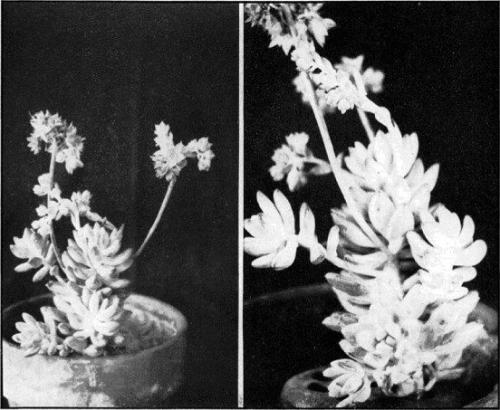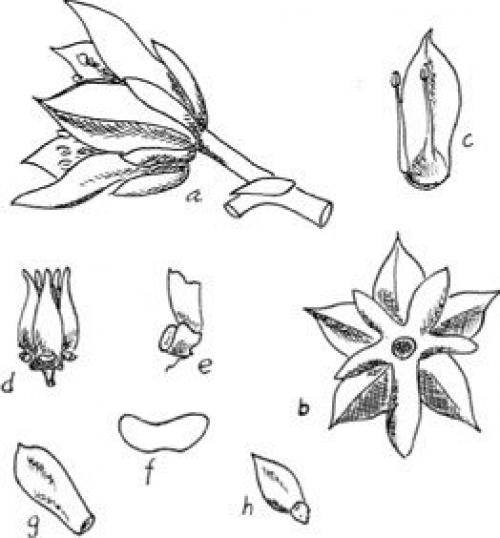The hybrid genus x Sedeveria
SEDEVERIA
A New Bigeneric Hybrid
By Eric Walther
“SEDEVERIA: hybridae inter Echeveriam et Sedum, characteribus intermediis sunt.”
Genotype: Sedeveria x Hummellii E. Walther.

FIG. 13 : LEFT: 21a. Sedeveria x Hummellii, flowering plant, app. x 025; RIGHT: 21b. Sedeveria x Hummellii, foliage, app. x 0.35
The new name here submitted is made necessary by the recent raising of a number of such bigeneric crosses, of which one is further described and illustrated herewith. Echeveria Derenbergii has been used as one parent, while of the several species of Sedum involved most appear to belong into our Section Bergerosedum of the genus Sedum, by Berger and others variously assigned to Pachysedum. Dendrosedum, etc. Bergerosedum as defined by us contains several Mexican species of Sedum characterised by their shrubby habit, scattered or subrosulate leaves and a lateral, axillary inflorescence. In the possession of this last character, these Sedum-species agree with Echeveria, from which fact we may speculate as to the derivation of Echeveria from this portion of the immense genus Sedum.
More detailed information of the chromosome constitution of the group would be most interesting, and may be forthcoming shortly. The several hybrids are usually clearly intermediate between the respective parents, even if the characters of the obviously more ancient genus Sedum appear to be dominant.
21. SEDEVERIA x Hummellii sp. nov.
“Hybridae inter Echeveriam Derenbergii J. A. Purpus et Sedum pachyphyllum Rose sunt.”
Description:
Subshrub, to 10 cm. tall, branching from base and above; leaves numerous, spirally scattered, scarcely rosulate, obovate-oblong, cuneate, at apex obtuish to acute, thick, to 35 mm. long, color biscay-green, at apex indian-red to vinaceous-russet; inflorescences several, always lateral and axillary ; peduncle to 12 cm. long, slender, orange-cinnamon, bracts few, to 15 mm. long, ovate-elliptic, acute, courge-green to light-grape-green; branches two to three, secund, each with 5 or more flowers; pedicels to 7 mm. long; sepals unequal, subterete, obtuse, appressed, colored as bracts; petals ascending, somewhat spreading above, keeled, acute, 10 mm, long, basal hollow shallow, color empire-yellow, slightly darker on keel ; carpels 6 mm. long, citron-green; nectaries reniform, 112 mm, wide, chartreuse-yellow. Flowers March.
Remarks :
We take pleasure in dedicating this hybrid to E. C. Hummel of Inglewood, California, in recognition of his enterprise in the making of these various experimental crosses. The affinity of the present hybrid with Sedum pachyphyllum is evident, and it might be described as a larger version of that plant. The influence of Echeveria Derenbergii is less obvious, but may he seen in the larger, subangular leaves, the larger, more open flower-clusters, the larger flowers with petals thicker, darker and more prominently keeled.
Type:
Herbarium, California Academy of Science, Golden Gate Park, San Francisco; grown at Strybing Arboretum and Botanic Garden.

FIG. 14 Sedeveria x Hummellii. a. Corolla, sideview, app. x 2. b. Basal view of calyx, app. x 2. c. Inner view of petal, app. 2. d. Carpels, app. x 2. e. Nectary, app. x 8. f. Nectary, app, x 8. g. Leaf, app. 0.4. h. Bract, app. 0.4.